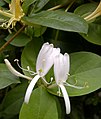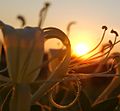Honeysuckle
Honeysuckles are arching shrubs or twining vines in the genus Lonicera (/lɒˈnɪsərə/) of the family Caprifoliaceae, native to northern latitudes in North America and Eurasia. Approximately 180 species of honeysuckle have been identified in both continents. Widely known species include Lonicera periclymenum (common honeysuckle or woodbine), Lonicera japonica (Japanese honeysuckle, white honeysuckle, or Chinese honeysuckle) and Lonicera sempervirens (coral honeysuckle, trumpet honeysuckle, or woodbine honeysuckle). L. japonica is a highly invasive species considered a significant pest in parts of North America, Europe, South America, Australia, and Africa.
| Honeysuckle Temporal range: | |
|---|---|
 | |
 | |
| 1. A flowering branch, 2. A fruiting branch, 3. Longitudinal section of a flower, 4. Fruit cut horizontally. | |
| Scientific classification | |
| Kingdom: | Plantae |
| Clade: | Tracheophytes |
| Clade: | Angiosperms |
| Clade: | Eudicots |
| Clade: | Asterids |
| Order: | Dipsacales |
| Family: | Caprifoliaceae |
| Subfamily: | Caprifolioideae |
| Genus: | Lonicera L. |
| Type species | |
| Lonicera caprifolium | |
| Species | |
| See text - selected species | |
| Synonyms | |
| |
Some species are highly fragrant and colorful, so are cultivated as ornamental garden plants. In North America, hummingbirds are attracted to the flowers, especially L. sempervirens and L. ciliosa (orange honeysuckle). Honeysuckle derives its name from the edible sweet nectar obtainable from its tubular flowers. The name Lonicera stems from Adam Lonicer, a Renaissance botanist.
Description

Most species of Lonicera are hardy twining climbers, with a minority of shrubby habit. Some species (including Lonicera hildebrandiana from the Himalayan foothills and L. etrusca from the Mediterranean) are tender and can be grown outside only in subtropical zones. The leaves are opposite, simple oval, 1–10 cm (0.39–3.94 in) long; most are deciduous but some are evergreen.
Many of the species have sweetly scented, bilaterally symmetrical flowers that produce a sweet, edible nectar, and most flowers are borne in clusters of two (leading to the common name of "twinberry" for certain North American species). Both shrubby and vining sorts have strongly fibrous stems which have been used for binding and textiles.
The fruit is a red, blue or black spherical or elongated berry containing several seeds; in most species the berries are mildly poisonous, but in a few (notably Lonicera caerulea) they are edible and grown for home use and commerce. Most honeysuckle berries are attractive to wildlife, which has led to species such as L. japonica and L. maackii spreading invasively outside of their home ranges. Many species of Lonicera are eaten by the larvae of some Lepidoptera species—see a list of Lepidoptera that feed on honeysuckles.
Invasive species
The spread of L. japonica in North America began in the United States in 1806, and it was widely cultivated by the 1860s. It was first discovered in Canada in Ontario forests in 1976, and became invasive by 2007. L. japonica was introduced in Australia between 1820 and 1840.
Several species of honeysuckle have become invasive when introduced outside their native range, particularly in North America, Europe, South America, Australia, and Africa. Invasive species include L. japonica, L. maackii, L. morrowii, L. tatarica, and the hybrid between the last two, L. × bella.
Cultivation
Honeysuckles are valued as garden plants, for their ability to cover unsightly walls and outbuildings, their profuse tubular flowers in early summer, and the intense fragrance of many varieties. The hardy climbing types need their roots in shade, and their flowering tops in sunlight or very light shade. Varieties need to be chosen with care, as they can become substantial. Cultivars of the dense, small-leaved L. nitida are used as low, narrow hedges.
The following hybrids have gained the Royal Horticultural Society's Award of Garden Merit:
- L. × heckrottii 'Gold Flame'
- L. 'Mandarin'
- L. × purpusii 'Winter Beauty'
- L. × tellmanniana
Other cultivars are dealt with under their species names.
The honeysuckle species L. japonica is grown as a commercial crop for traditional Chinese medicine use.
Phytochemicals and sensory effects
Honeysuckle is renowned for its colorful, fragrant flowers and variously colored fruit, indicating the presence of complex phytochemicals underlying these properties. Component analyses of berries from 27 different cultivars and 3 genotypes of edible honeysuckle (Lonicera caerulea var. kamtschatica) showed the presence of iridoids, anthocyanins, flavonols, flavanonols, flavones, flavan-3-ols, and phenolic acids. While sugars determine the level of sweetness in the berries, organic acids and polyphenols are responsible for the sour taste and tartness. Some 51 of the same compounds in berries are found in flowers, although the proportions of these compounds varied among cultivars studied.
Interaction with other species
Many insects in the order Lepidoptera visit honeysuckles as a food source. An example of this is the moth Deilephila elpenor. This nocturnal species of moth is especially attracted to honeysuckles, and they visit the flowers at night to feed on their nectar.
Selected species
Some 180 species of Lonicera are documented.
- Lonicera acuminata or Lonicera pampaninii – fragrant grove honeysuckle or vine honeysuckle
- Lonicera albiflora – white honeysuckle
- Lonicera alpigena – alpine honeysuckle
- Lonicera altmannii
- Lonicera × americana
- Lonicera angustifolia
- Lonicera anisocalyx
- Lonicera arborea
- Lonicera arizonica – Arizona honeysuckle
- Lonicera × bella – Bell's honeysuckle or showy fly honeysuckle
- Lonicera biflora
- Lonicera bournei
- Lonicera brevisepala
- Lonicera buchananii
- Lonicera buddleioides
- Lonicera caerulea – blue-berried honeysuckle
- Lonicera calcarata
- Lonicera calvescens
- Lonicera canadensis – Canada fly honeysuckle, American fly honeysuckle
- Lonicera caprifolium – goat-leaf honeysuckle, perfoliate honeysuckle
- Lonicera carnosifolis
- Lonicera cerviculata
- Lonicera chrysantha – Chrysantha honeysuckle
- Lonicera ciliosa – orange honeysuckle
- Lonicera ciliosissima
- Lonicera cinerea
- Lonicera codonantha
- Lonicera confusa
- Lonicera conjugialis – purpleflower honeysuckle
- Lonicera crassifolia
- Lonicera cyanocarpa
- Lonicera dasystyla – Tonkinese honeysuckle
- Lonicera dioica – limber honeysuckle
- Lonicera elisae
- Lonicera etrusca – Etruscan honeysuckle
- Lonicera fargesii
- Lonicera ferdinandii
- Lonicera ferruginea
- Lonicera flava – yellow honeysuckle
- Lonicera fragilis
- Lonicera fragrantissima – winter honeysuckle
- Lonicera fulvotomentosa
- Lonicera glutinosa
- Lonicera graebneri
- Lonicera gynochlamydea
- Lonicera harae
- Lonicera × heckrottii – golden flame honeysuckle
- Lonicera hellenica – Greek honeysuckle
- Lonicera hemsleyana
- Lonicera heterophylla
- Lonicera hildebrandiana – giant Burmese honeysuckle
- Lonicera hirsuta – hairy honeysuckle
- Lonicera hispida
- Lonicera hispidula – pink honeysuckle
- Lonicera humilis
- Lonicera hypoglauca
- Lonicera hypoleuca
- Lonicera implexa
- Lonicera inconspicua
- Lonicera inodora
- Lonicera interrupta – Chaparral honeysuckle
- Lonicera involucrata – bearberry honeysuckle
- Lonicera japonica – Japanese honeysuckle
- Lonicera jilongensis
- Lonicera kansuensis
- Lonicera kawakamii
- Lonicera korolkowii – blueleaf honeysuckle
- Lonicera lanceolata
- Lonicera ligustrina
- Lonicera litangensis
- Lonicera longiflora
- Lonicera longituba
- Lonicera maackii – Amur honeysuckle
- Lonicera macrantha
- Lonicera macranthoides
- Lonicera maximowiczii
- Lonicera microphylla
- Lonicera minuta
- Lonicera minutifolia
- Lonicera modesta
- Lonicera morrowii – Morrow's honeysuckle
- Lonicera mucronata
- Lonicera myrtillus
- Lonicera nervosa
- Lonicera nigra – black-berried honeysuckle
- Lonicera nitida – boxleaf honeysuckle
- Lonicera nubium
- Lonicera nummulariifolia
- Lonicera oblata
- Lonicera oblongifolia – swamp fly honeysuckle
- Lonicera oiwakensis
- Lonicera oreodoxa
- Lonicera orientalis
- Lonicera paradoxa
- Lonicera periclymenum – (common) honeysuckle, European honeysuckle, or woodbine
- Lonicera pileata – privet honeysuckle
- Lonicera pilosa – Mexican honeysuckle
- Lonicera praeflorens
- Lonicera prostrata
- Lonicera pyrenaica – Pyrenean honeysuckle
- Lonicera quinquelocularis – translucent honeysuckle
- Lonicera reticulata – grape honeysuckle
- Lonicera retusa
- Lonicera rhytidophylla
- Lonicera rupicola
- Lonicera ruprechtiana – Manchurian honeysuckle
- Lonicera saccata
- Lonicera schneideriana
- Lonicera semenovii
- Lonicera sempervirens – trumpet honeysuckle
- Lonicera serreana
- Lonicera setifera
- Lonicera similis – var. delavayi – Delavay honeysuckle
- Lonicera spinosa
- Lonicera splendida – evergreen honeysuckle
- Lonicera standishii – Standish's honeysuckle
- Lonicera stephanocarpa
- Lonicera subaequalis
- Lonicera subhispida
- Lonicera sublabiata
- Lonicera subspicata – southern honeysuckle
- Lonicera szechuanica
- Lonicera taipeiensis
- Lonicera tangutica
- Lonicera tatarica – Tatarian honeysuckle
- Lonicera tatarinowii
- Lonicera tomentella
- Lonicera tragophylla – Chinese honeysuckle
- Lonicera tricalysioides
- Lonicera trichogyne
- Lonicera trichosantha
- Lonicera tubuliflora
- Lonicera utahensis – Utah honeysuckle
- Lonicera villosa – mountain fly honeysuckle
- Lonicera virgultorum
- Lonicera webbiana
- Lonicera xylosteum – fly woodbine
- Lonicera yunnanensis
Several fossil species are known from the Miocene of Asia.
- Lonicera japonica
- L. ciliosa
- L. japonica fruit
- L. hispidula
- L. sempervirens
- L. tatarica
- L.caprifolium, Chèvrefeuille
- flower buds.
References
External links



- Flora of China: Lonicera species list
- . . 1914.
This article uses material from the Wikipedia English article Honeysuckle, which is released under the Creative Commons Attribution-ShareAlike 3.0 license ("CC BY-SA 3.0"); additional terms may apply (view authors). Content is available under CC BY-SA 4.0 unless otherwise noted. Images, videos and audio are available under their respective licenses.
®Wikipedia is a registered trademark of the Wiki Foundation, Inc. Wiki English (DUHOCTRUNGQUOC.VN) is an independent company and has no affiliation with Wiki Foundation.







